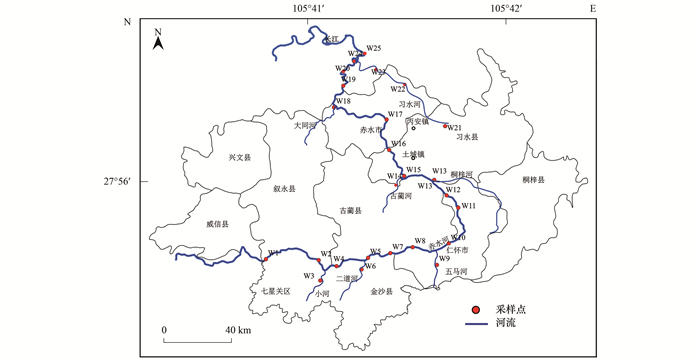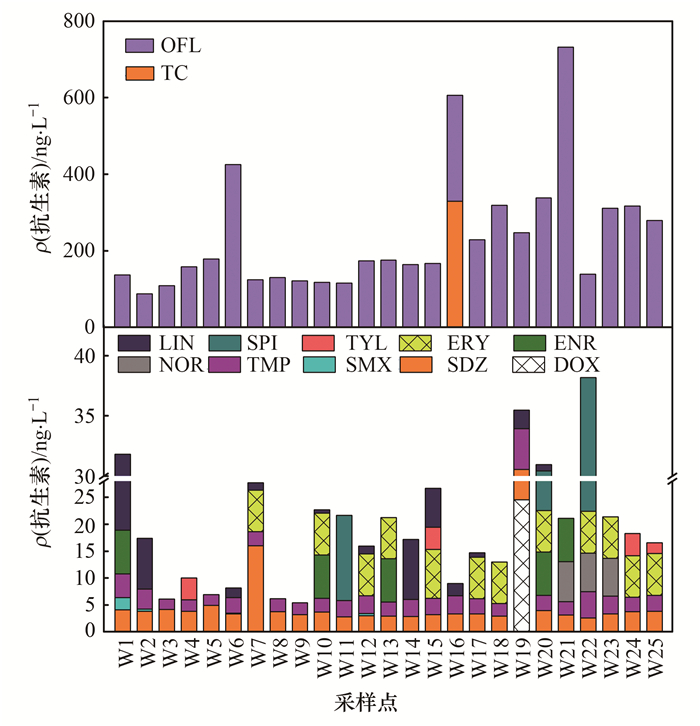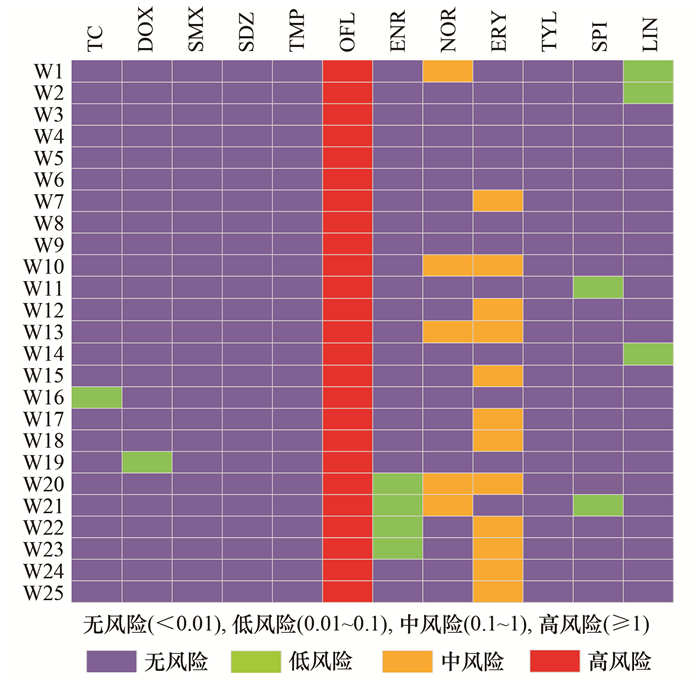2. 贵州喀斯特环境生态系统教育部野外科学观测研究站, 贵阳 550025;
3. 重庆大学三峡库区生态环境教育部重点实验室, 重庆 400045;
4. 贵州省分析测试研究院, 贵阳 550000;
5. 贵州大学土木工程学院, 贵阳 550025
2. Guizhou Karst Environmental Ecosystem Observation and Research Station, Ministry of Education, Guiyang 550025, China;
3. Key Laboratory of the Three Gorges Reservoir Region's Eco-Environment, Ministry of Education, Chongqing University, Chongqing 400045, China;
4. Guizhou Academy of Testing and Analysis, Guiyang 550000, China;
5. College of Civil Engineering, Guizhou University, Guiyang 550025, China
抗生素是一种由细菌和真菌产生或人工合成的、具有抑制微生物活性的一类抗菌药物[1], 自世界上第一种抗生素青霉素产生以来, 大量抗菌药物被广泛应用于人类医疗和畜禽养殖[2].据报道, 2013年我国的抗生素使用量为16.2万t, 占全球抗生素使用量的一半以上, 比英国和北欧大部分国家的使用量(规定的日标准剂量)高出6倍[3].但是抗生素在大多数生物体内并没有被完全代谢吸收, 摄入后大约有30% ~90%会以母体化合物及代谢产物的形式排出体外[4].现有研究表明目前的污水处理工艺不能对抗生素进行有效去除[5, 6], 其会随污水处理厂出水排入水体, 抗生素的化学稳定性和生物积累能力将导致环境中的低浓度抗生素对水生生物甚至整个水生态环境带来潜在风险[7, 8].此外, 水体残留的抗生素还会促进耐药菌(antibiotic resistance bacteria, ARB)和抗性基因(antibiotic resistance genes, ARGs)的形成[9].近年来抗生素作为一类新兴污染物在国内天然水体中广泛检出, 如长江(ND~1 490 ng·L-1)[10]、珠江(ND~1 139.4 ng·L-1)[11]、黄河(ND~3 474 ng·L-1)[12]、松花江(ND~73.1 ng·L-1)[13]和太湖(ND~94.91 ng·L-1)[14]等.
赤水河处于川、滇、黔三省接壤地带, 是长江上游唯一没有建坝的河流, 干流总长444.5 km, 流域面积20 440 km2, 赤水河流域作为长江上游珍稀鱼类的自然保护水域及重要的水源地涵养区, 具有重大的水生态环境保护意义, 其主要支流包括五马河、古蔺河、盐津河、白沙河和桐梓河等[15].近年来, 随着赤水河流域内经济、城镇化和工业化的快速发展, 水环境质量面临较大威胁.当前对赤水河流域污染的报道多集中在氮素和重金属等常规污染物特征的研究[16, 17], 对于抗生素这一新兴有机污染物的研究较少.因此, 本文以赤水河流域地表水作为研究对象, 选择贵州省内水环境中检出率较高的四大类抗生素: 磺胺类(SAs)8种、四环素类(TCs)4种、喹诺酮类(QNs)5种和大环内酯类(MLs)4种共21种抗生素作为目标污染物, 分析这4类抗生素在该流域的污染水平及空间分布规律, 初步评价抗生素对水体的生态环境风险, 以期为赤水河流域的抗生素污染防治提供数据参考和决策依据.
1 材料与方法 1.1 仪器与试剂仪器与耗材: LC-MS(LC: Agilent Technologies 1290 Infinity; MS: AB SCIEX QTRAP 6470)、色谱柱(ZORBAX Eclipse Plus C18 1.8 μm 3.0 mm×50 mm Column, Agilent Technologies)、24孔固相萃取装置(Waters, 美国)、HLB小柱(6 mL/500 mg, Waters, 美国)、旋转蒸发仪(Heidolph, 德国)、电子分析天平(上海精科雷磁化学仪器公司, 中国)和0.45 μm微孔滤膜(玻璃纤维, 美国Millipore公司).
试剂: 抗生素标准品包括磺胺类8种: 磺胺嘧啶(sulfadiazine, SDZ)、磺胺甲唑(sulfamethoxazole, SMX)、甲氧苄啶(trimethoprim, TMP)、磺胺甲基嘧啶(sulfamerazine, SMR)、磺胺吡啶(sulfapyridine, SD)、磺胺二甲嘧啶(sulfadimidine, SMZ)、磺胺对甲氧嘧啶(sulfametoxydiazine, SMD)和磺胺间甲氧嘧啶(sulfamonomethoxine, SMM); 四环素类4种: 四环素(tetracycline, TC)、土霉素(oxytetracycline dihydrate, OTC)、强力霉素(doxycycline, DOX)和金霉素(chlorotetracycline hydrochloride, CTC); 喹诺酮类5种: 氧氟沙星(ofloxacin, OFL)、诺氟沙星(norfloxacin, NOR)、恩诺沙星(enrofloxacin, ENR)、环丙沙星(Ciprofloxacin, CIP)和依诺沙星(enoxacin, ENX); 大环内酯类4种: 红霉素(erythrocin, ERY)、螺旋霉素(spiramycin, SPI)、泰乐菌素(tylosin, TYL)和林可霉素(lincomycin, LIN)均购自北京百灵威科技有限公司, 纯度大于99%; 甲醇(色谱纯, MERCK, 德国)、磷酸二氢钠(分析纯)和乙二胺四乙酸二钠盐(色谱纯)购自北京百灵威科技有限公司; 本实验用水均为超纯水(Milli-Q超纯水系统, Waters, 美国).
1.2 样品采集与预处理于2020年11月对赤水河进行水样采集, 参考贵州省赤水河流域主要河流考核断面, 在赤水河干流、主要支流(二道河、五马河、桐梓河等)一共设置25个采样点, 其中干流16个, 支流9个, 见图 1.采用有机玻璃采水器采集赤水河表层水样2 L(采集深度为水面以下0.5 m), 加入2 mL甲醇抑制微生物活性, 避光保存, 24 h内尽快运回实验室进行提取分析.

|
图 1 赤水河流域采样点示意 Fig. 1 Schematic diagram of sampling points in Chishui River basin |
采用0.45 μm玻璃纤维滤膜对水样进行过滤以除去大颗粒物质, 加入适量磷酸水溶液(体积比为50%)调至pH=3左右, 再加入2.5 mL Na2EDTA(100 g·L-1)溶液摇匀.首先对HLB小柱进行活化: 依次向HLB小柱内加入6 mL甲醇、3 mL超纯水和6 mL磷酸二氢钠水溶液活化小柱, 调节小柱流速为5 mL·min-1(2滴·s-1), 活化完成后以相同流速进行水样的富集, 水样富集结束后用10 mL超纯水淋洗进样瓶以确保水样的完全富集, 随后在负压条件下对HLB固相萃取小柱进行真空干燥60 min保证抽干水分.然后依次用6 mL甲醇和2%氨水甲醇(体积比为2%)洗脱固相萃取小柱, 洗脱速度控制在1 mL·min-1, 用50 mL鸡心瓶收集洗脱液, 在45~50℃下旋转蒸发近干, 用甲醇复溶至1 mL, 经过0.22 μm的有机针头过滤器过滤后移入棕色进样小瓶, 使用LC-MS上机分析.抗生素固相萃取过程和参数见表 1.
|
|
表 1 抗生素固相萃取过程和参数 Table 1 Processes and parameters of solid phaseextraction of antibiotics |
1.3 仪器分析条件
LC检测条件: 进样量为5 μL; 设置柱温为40℃; 流动相A为0.1%甲酸水; 流动相B为乙腈; 梯度洗脱分离步骤见表 2.质谱测定条件: 采用电喷雾离子源(ESI)正离子模式、多反应离子监测(MRM)模式进行检测, 雾化器压强为40 psi(40×6.9 kPa), 4 000 V毛细管电压, 气体干燥的流速和温度分别为6 L·min-1和300℃.
|
|
表 2 梯度洗脱分离步骤 Table 2 Gradient elution separation step |
1.4 质量控制
本实验的仪器分析流程遵守美国EPA的要求进行严格质量控制与保证, 采用外标法对本次的样品进行定量分析, 每隔10个样品对80 μg·L-1的标样进行一次测定, 以保证仪器在使用过程中测试性能未产生较大误差.用甲醇配制抗生素混标, 然后经逐级稀释配制成0、10、50、80、100、150和200 μg·L-1的7个质量浓度的系列标准溶液, 标准曲线的相关系数均大于0.99, 用200 mL超纯水做空白对照实验, 加入质量浓度为200 μg·L-1作空白加标回收实验, 每个样品设置3个平行样, 结果表明空白组样品中无目标化合物检出. 21种抗生素的空白加标回收率为81.7% ~132.7%, 加标平行样和样品平行样的相对标准偏差RSD在0.58% ~14.54%之间, 目标抗生素的检出限为0.027~1.268 ng·L-1.
2 结果与讨论 2.1 赤水河流域抗生素浓度污染水平各种抗生素的浓度水平如表 3所示, 通过对赤水河流域地表水中4类21种抗生素进行测定分析可知, 21种抗生素中一共检出12种抗生素, 其中TMP、SDZ和OFL的检出率最高, 为100%, ENR、ERY和LIN的检出率在25% ~62.5%, 其余抗生素的检出率均低于20%.四环素类抗生素检出2种, 磺胺类抗生素检出3种, 喹诺酮类抗生素检出3种, 大环内酯类抗生素检出4种, 总浓度水平在ND~1 166.97 ng·L-1.
|
|
表 3 赤水河流域地表水中抗生素的浓度与检出率 Table 3 Concentration and detection rate of antibiotics in the surface water of Chishui River basin |
在赤水河地表水样品中磺胺类抗生素SDZ和TMP的检出率均为100%, 其中SDZ的检出浓度范围为2.54~16.00 ng·L-1, 据研究报道, 磺胺类抗生素大多具有良好的水溶性, 使其易于在水体中赋存并扩散[18], 其中SMX是由美国食品及药物管理局规定的需要优先被检测的14种磺胺类药物中的一种[19, 20], 在2014年我国地表水环境中的检出报道次数最多已达到10次[21], 且检出率均大于60%.甲氧苄啶(TMP)作为一种磺胺类增效剂, 通常会与磺胺类抗生素联合使用以增加治疗效果, 这可能是导致其在本次研究区域中的频繁检出的原因.四环素类抗生素总体上在本次研究区域类的检出率和检出浓度均较低, 这可能是由于大多数TCs是聚酮类化合物且在水中溶解性较低, 且其容易发生光降解[22].喹诺酮类抗生素的总检出浓度范围在ND~732.36 ng·L-1, 其中氧氟沙星的检出浓度在本研究中的所有抗生素中处于首位, 最高检出浓度732.36 ng·L-1, 平均检出浓度为221.59 ng·L-1, 这与Zhen等[23]对珠海市河流中抗生素浓度水平的研究结果一致; 其次是恩诺沙星(ENR), 为ND~8.14 ng·L-1, 平均检出浓度为1.62 ng·L-1, 该浓度值低于我国库尔勒地区孔雀河中[24]的平均检出浓度(36.64 ng·L-1), 这可能与不同地区使用该种抗生素的数量和频率有关.喹诺酮类抗生素是我国临床应用最广泛、生产量最大的抗生素之一, 因其具有价格便宜、与其他药物之间无交叉耐药性的特性被大量用于人类医疗和畜禽养殖[25].此外, 该类抗生素在水中半衰期较长且不易降解, 而当前污水处理工艺对喹诺酮类抗生素的去除效果较低, 使污水处理厂出水中仍然含有较高浓度残留[26], 造成其在水环境中检出率和检出浓度均较高.大环内酯类抗生素是典型的人畜共用抗生素, 其检出浓度和检出率在本次研究中处于中等水平, 平均检出浓度从大到小依次为: 红霉素(3.76 ng·L-1)>林可霉素(1.91 ng·L-1)>螺旋霉素(1.58 ng·L-1)>泰乐菌素(0.57 ng·L-1), 其中ρ(红霉素)的检出范围为ND~9.07 ng·L-1, 远低于张干等[27]对珠江广州段河流(ND~105 ng·L-1).有研究表明, 红霉素是我国水环境中检出率较高的大环内酯类抗生素, 然而在一些欧洲发达国家, 克拉霉素才是最常检出的抗生素, 这说明不同国家对该类抗生素的使用存在一定的差异性[28]; 林可霉素的检出率和检出浓度范围分别为62.5%和ND~12.89 ng·L-1, 平均检出浓度为1.91 ng·L-1, 低于王娅南等[29]对贵阳南明河抗生素报道的平均检出浓度(63.7 ng·L-1), 其在国内主要应用于畜禽养殖业, 据2015年张芊芊[30]对我国36种抗生素用量水平的研究, 发现该种抗生素的使用量位居第一.
2.2 赤水河流域地表水抗生素与国内外河流对比分析与国内外地表水中抗生素检出浓度相比, 赤水河流域水体的氧氟沙星(OFL)平均检出浓度高于我国的海河、渭河、长江三角洲水域及埃塞俄比亚的阿瓦什河流域, 与珠江广州段的抗生素平均检出浓度相当, 略低于北京温榆河的抗生素浓度; 磺胺嘧啶(SDZ)略高于金沙江, 与珠江流域处于同一污染水平; 甲氧苄啶(TMP)的浓度水平与长江三角洲河流一致均处于较低的检出水平, 低于我国珠江、海河、渭河、温榆河和胶州湾水体抗生素检出浓度; 大环内酯类(MLs)抗生素的检出浓度普遍低于国内外河流.总的来说, 除了氧氟沙星(OFL)和四环素(TC)处于较高的检出水平外, 其余抗生素基本为中等及以下污染水平(表 4), 这与每种抗生素在流域内不同区域的使用类型和数量存在差异有关.
|
|
表 4 国内外部分河流抗生素污染水平1) Table 4 Concentration level of antibiotics in some rivers in China and foreign areas |
2.3 赤水河流域抗生素空间分布特征及相关性分析
赤水河流域地表水各采样点的抗生素浓度分布如图 2所示, 总浓度范围为105.00~753.50 ng·L-1.对于赤水河的分段, 一般以仁怀市二郎镇以上为上游段, 二郎镇至赤水市丙安镇复兴场为中游段, 丙安镇复兴场以下为下游段[42].总体上看, 抗生素平均浓度分布遵循: 下游(359.41 ng·L-1)>中游(224.59 ng·L-1)>上游(179.72 ng·L-1), 抗生素在支流的检出浓度大于干流抗生素浓度.

|
图 2 赤水河流域地表水中21种抗生素浓度分布 Fig. 2 Concentration distribution of 21 antibiotics in the surface water of Chishui River basin |
赤水河上游段(W1~W8)主要分布于毕节市七星关区周围的一些农村地区, 如岔河村、倒角头村和纳坡村等, 不管是从人口数量还是经济发展速度明显低于中下游的仁怀和赤水等人为活动频繁的地区.上游段的W7点位的磺胺嘧啶为16 ng·L-1, 高于其它采样点的检出浓度, 磺胺嘧啶是典型的农用及兽用抗生素, W7附近多为赤水河岸边的农用耕地, 存在个体家禽散养户, 农田作物耕作过程中经常会施用动物养殖粪便作为肥料.据研究报道, 由于抗生素在动物体内的不完全代谢, 使得畜禽粪便中往往含有较高浓度的抗生素, 如Zhou等[43]对江苏省畜禽粪便有机肥中32种常用兽药抗生素的残留状况进行了研究, 发现大部分畜禽粪便有机肥中存在磺胺甲嗪和四环素(TC), 其含量分别高达5 650 μg·kg-1和1 920 μg·kg-1, 含有较高浓度抗生素粪肥通过土壤的渗透作用汇集至赤水河周围的支流中, 这可能是该种抗生素检出浓度较高的原因.
赤水河中游(W9~W17)处于仁怀市至赤水市丙安镇段, 抗生素检出浓度从大到小依次为: W16>W17>W13>W15>W12>W14>W10>W11>W9, 该区域段附近有较多旅游景区、居民生活居住区和酿酒工业区, 人为活动较为频繁.W16点位于土城镇, 是唯一检出四环素的采样点, 检出浓度为329.45 ng·L-1, 四环素在我国主要作为兽用抗生素, 该点位附近分布着养殖场, 这可能是造成该点位四环素检出浓度较高的原因.W13和W14均处于赤水河流域的支流, 分别为桐梓河和古蔺河, 造成其检出浓度高于干流的原因可能是该支流段有生活污水或者养殖废水的排入口[44], 其次可能是由于支流段水量和流速均很低, 导致抗生素在水体中的持续累积和难迁移.
赤水河下游(W18~W25)主要流经赤水市金华镇、先市镇、长沙镇和四川省合江县等, 除W22采样点外其余6个采样点的抗生素总检出浓度都高于赤水河中上游流域段.W21点处的抗生素检出浓度最高, 其次是W20, 浓度分别为753.5 ng·L-1和368.9 ng·L-1, W21位于赤水河的主要支流习水河, 该采样点位氧氟沙星的抗生素检出浓度(732.36 ng·L-1)处于本次抗生素检出浓度最大值, W21和W20点位周围受人为活动因素影响较大, 其中W20点位处于四川省泸州市先市镇某中学附近, 人口分布较为密集.因此, 生活污水的排放可能是抗生素检出浓度较高的主要原因.此外, W25采样点位于赤水河汇入长江前1 km位置, 其抗生素总检出浓度(295.1 ng·L-1)低于处于习水河与赤水河汇合处上游1 km位置的W23(332.5 ng·L-1)采样点的抗生素浓度, 这可能是由于赤水河干流段在汇入长江附近水量和流速较大以及河流存在一定的自净功能、对支流较高浓度的抗生素有稀释和降解作用的缘故.
采用Pearson相关系数法对赤水河流域地表水的抗生素与常规水质指标pH、电导率(EC)和总固体溶解度(TDS)进行分析, 结果如表 5所示, 可以看出, TMP与SMX和LIN存在极显著正相关关系(P<0.01), 相关系数分别是0.510和0.509; SMX与LIN之间呈极显著正相关(P<0.01), 相关性系数为0.657, 这种抗生素之间的相关性分析可能表明TMP与SMX和LIN, 以及SMX与LIN可能存在相同的来源.NOR与电导率之间呈显著负相关(P<0.05), 而与总固体溶解度之间呈极显著负相关(P<0.01), SPI与pH之间呈显著负相关(P<0.05).该结果表明, 在复杂的水环境中, 抗生素的浓度容易受多种水质因素的影响.
|
|
表 5 赤水河流域地表水中抗生素浓度与水质参数的Pearson相关性分析1) Table 5 Pearson correlation analysis of antibiotic concentration and water quality parameters in the surface water of Chishui River basin |
2.4 抗生素生态风险评价
当前国内外暂未制定对抗生素这类新兴污染物的环境限制浓度标准, 因此为了评估赤水河流域水体抗生素暴露而产生的潜在生态风险, 根据欧洲技术指导文件(TGD)里关于污染物环境风险的评价方法, 采用风险商值法评估抗生素对水环境的生态风险, 即环境实际测定浓度与预测无效应浓度的比值[45], 计算公式如下:

|
(1) |

|
(2) |
式中, RQ为在环境中的实际检出浓度(measured environmental concentration, MEC)与预测无效应浓度(predicted no effect concentration, PNEC)的比值, EC50(半数效应浓度, ng·L-1)或者LC50(半数致死浓度, ng·L-1)与评价因子(assessment factors, AF)的比值.本研究的水生生物毒理数据库资料主要从美国ECOSAR数据库(https://cfpub.epa.gov/ecotox/)和部分已有研究中查找确定.基于最严重的情况考虑, 环境中实测浓度(MEC)选择最大值计算, 每种抗生素对应的水生生物毒性敏感数据如表 6所示.
|
|
表 6 抗生素对应最敏感物种的毒理数据 Table 6 Aquatic toxicity data of antibiotics to the most sensitive aquatic species |
Hernando等[61]提出的RQs分类方法来评估生态风险等级: 低风险(0.01≤RQs<0.1)、中等风险(0.1≤RQs<1)和高风险(RQs≥1).根据计算的RQ值绘制赤水河流域水体抗生素的风险热度分布, 从图 3可以看出, 研究区域抗生素生态风险基本处于低风险范围, 但是也发现有6种抗生素处于中风险, 其中包括2种四环素类(TC和DOX)、2种喹诺酮类(ENR、NOR)、1种大环内酯类(ERY)和1种林可霉素类(LIN).除此之外, 处于高风险水平的抗生素为氧氟沙星(OFL), RQ值均大于1, 平均值为19.61, 对研究区地表水中相对应的敏感生物造成了严重生态风险, 在本研究区域内其高风险点位所占比例为100%, 是主要的生态风险因子.该种抗生素具有较低的最大无效应浓度值(11.3 ng·L-1), 易对水环境造成危害, 有研究发现, 在西方国家, 具有较高生态风险的氧氟沙星已经被列为水环境中优先控制的抗生素.虽然大部分抗生素处于低风险范围, 但是抗生素在水体的长时间残留除了对水生生物引发一定的急性或者慢性毒性效应以外, 还会刺激水环境中的病原微生物体内产生抗性基因, 降低抗生素的治疗效果, 同时对原有的水生态平衡系统产生不利影响[62].综合分析可知, 赤水河流域地表水中抗生素存在一定的生态风险.

|
图 3 赤水河流域地表水抗生素RQ值 Fig. 3 RQ values of antibiotics in Chishui River basin |
(1) 赤水河流域地表水中共检出12种抗生素, 总浓度检出水平为ND~1 166.97 ng·L-1, 检出率为3.1% ~100%.平均检出浓度最高的抗生素为OFL, 为221.59 ng·L-1, 其次是TC、SDZ、ERY和TMP, 平均检出浓度分别是13.18、4.11、3.76和2.92 ng·L-1, 对比国内外研究的地表水抗生素浓度, 氧氟沙星和四环素处于较高的污染检出水平, 其余抗生素处于中低等污染水平.
(2) 地表水抗生素浓度的空间分布表现为: 下游>中游>上游的分布趋势, 在人为活动密集、畜禽养殖聚集、经济发展快的地区抗生素检出浓度较高.相关性结果分析表明, 水体抗生素浓度与pH、EC和TDS之间存在显著相关性.
(3) 生态环境风险评价结果表明, 在检出的12种抗生素中, 包括高风险1种, 中风险6种, 氧氟沙星在所有点位均处于高风险水平, 其对水生生物的生态毒性风险应引起重视.
| [1] | Danner M C, Robertson A, Behrends V, et al. Antibiotic pollution in surface fresh waters: occurrence and effects[J]. Science of the Total Environment, 2019, 664: 793-804. DOI:10.1016/j.scitotenv.2019.01.406 |
| [2] | Liu X H, Lu S Y, Guo W, et al. Antibiotics in the aquatic environments: a review of lakes, China[J]. Science of the Total environment, 2018, 627: 1195-1208. DOI:10.1016/j.scitotenv.2018.01.271 |
| [3] | Qiao M, Ying G G, Singer A C, et al. Review of antibiotic resistance in China and its environment[J]. Environment International, 2018, 110: 160-172. DOI:10.1016/j.envint.2017.10.016 |
| [4] | Zhou L J, Ying G G, Zhao J L, et al. Trends in the occurrence of human and veterinary antibiotics in the sediments of the Yellow River, Hai River and Liao River in northern China[J]. Environmental Pollution, 2011, 159(7): 1877-1885. DOI:10.1016/j.envpol.2011.03.034 |
| [5] | Rodriguez-Mozaz S, Vaz-Moreira I, Giustina S V D, et al. Antibiotic residues in final effluents of European wastewater treatment plants and their impact on the aquatic environment[J]. Environment International, 2020, 140. DOI:10.1016/j.envint.2020.105733 |
| [6] | Wang J L, Chu L B, Wojnárovits L, et al. Occurrence and fate of antibiotics, antibiotic resistant genes (ARGs) and antibiotic resistant bacteria (ARB) in municipal wastewater treatment plant: an overview[J]. Science of the Total Environment, 2020, 744. DOI:10.1016/j.scitotenv.2020.140997 |
| [7] | Li Y, Zhang L Y, Liu X S, et al. Ranking and prioritizing pharmaceuticals in the aquatic environment of China[J]. Science of the Total Environment, 2019, 658: 333-342. DOI:10.1016/j.scitotenv.2018.12.048 |
| [8] | Qiu W H, Sun J, Fang M J, et al. Occurrence of antibiotics in the main rivers of Shenzhen, China: association with antibiotic resistance genes and microbial community[J]. Science of the Total Environment, 2019, 653: 334-341. DOI:10.1016/j.scitotenv.2018.10.398 |
| [9] | Chen Y H, Su J Q, Zhang J Y, et al. High-throughput profiling of antibiotic resistance gene dynamic in a drinking water river-reservoir system[J]. Water Research, 2019, 149: 179-189. DOI:10.1016/j.watres.2018.11.007 |
| [10] | Wang G A, Zhou S H, Han X K, et al. Occurrence, distribution, and source track of antibiotics and antibiotic resistance genes in the main rivers of Chongqing city, southwest China[J]. Journal of Hazardous Materials, 2020, 389. DOI:10.1016/j.jhazmat.2020.122110 |
| [11] | Li S, Shi W Z, Li H M, et al. Antibiotics in water and sediments of rivers and coastal area of Zhuhai City, Pearl River estuary, south China[J]. Science of the Total Environment, 2018, 636: 1009-1019. DOI:10.1016/j.scitotenv.2018.04.358 |
| [12] | Feng J L, Liu Q, Ru X L, et al. Occurrence and distribution of priority pharmaceuticals in the Yellow River and the Huai River in Henan, China[J]. Environmental Science and Pollution Research, 2020, 27(14): 16816-16826. DOI:10.1007/s11356-020-08131-6 |
| [13] | Wang W H, Zhang W F, Liang H, et al. Seasonal distribution characteristics and health risk assessment of typical antibiotics in the Harbin section of the Songhua River basin[J]. Environmental Technology, 2019, 40(20): 2726-2737. DOI:10.1080/09593330.2018.1449902 |
| [14] | Li L, Zhao X L, Liu D, et al. Occurrence and ecological risk assessment of PPCPs in typical inflow rivers of Taihu Lake, China[J]. Journal of Environmental Management, 2021, 285. DOI:10.1016/j.jenvman.2021.112176 |
| [15] |
任奕蒙, 岳甫均, 徐森, 等. 利用氮氧同位素解析赤水河流域水体硝酸盐来源及其时空变化特征[J]. 地球与环境, 2019, 47(6): 820-828. Ren Y M, Yue F J, Xu S, et al. Temporal and spatial variation of nitrate sources in the Chishui River watershed based on isotope approach[J]. Earth and Environment, 2019, 47(6): 820-828. |
| [16] |
于霞, 安艳玲, 吴起鑫. 赤水河流域表层沉积物重金属的污染特征及生态风险评价[J]. 环境科学学报, 2015, 35(5): 1400-1407. Yu X, An Y L, Wu Q X. Pollution characteristics and ecological risk assessment of heavy metals in the sediments of Chishui River[J]. Acta Scientiae Circumstantiae, 2015, 35(5): 1400-1407. |
| [17] |
秦立, 付宇文, 吴起鑫, 等. 赤水河流域土地利用结构对氮素输出的影响[J]. 长江流域资源与环境, 2019, 28(1): 175-183. Qin L, Fu Y W, Wu Q X, et al. Effects of land use structure on nitrogen export in Chishui River watershed of southwest China[J]. Resources and Environment in the Yangtze Basin, 2019, 28(1): 175-183. |
| [18] |
丁剑楠, 刘舒娇, 邹杰明, 等. 太湖表层水体典型抗生素时空分布和生态风险评价[J]. 环境科学, 2021, 42(4): 1811-1819. Ding J N, Liu S J, Zou J M, et al. Spatiotemporal distributions and ecological risk assessments of typical antibiotics in surface water of Taihu Lake[J]. Environmental Science, 2021, 42(4): 1811-1819. |
| [19] |
银仁莉. 超声联合臭氧技术降解磺胺甲恶唑的研究[D]. 哈尔滨: 哈尔滨工业大学, 2014. Yin R L. Study on sulfamethoxazole degradation by ultrasound/ozone oxidation process[D]. Harbin: Harbin Institute of Technology, 2014. |
| [20] | Luo Y, Xu L, Rysz M, et al. Occurrence and transport of tetracycline, sulfonamide, quinolone, and macrolide antibiotics in the Haihe River basin, China[J]. Environmental Science & Technology, 2011, 45(5): 1827-1833. |
| [21] |
王丹, 隋倩, 赵文涛, 等. 中国地表水环境中药物和个人护理品的研究进展[J]. 科学通报, 2014, 59(9): 743-751. Wang D, Sui Q, Zhao W T, et al. Pharmaceutical and personal care products in the surface water of China: a review[J]. Chinese Science Bulletin, 2014, 59(9): 743-751. |
| [22] | Chen Y, Hu C, Qu J H, et al. Photodegradation of tetracycline and formation of reactive oxygen species in aqueous tetracycline solution under simulated sunlight irradiation[J]. Journal of Photochemistry and Photobiology A: Chemistry, 2008, 197(1): 81-87. DOI:10.1016/j.jphotochem.2007.12.007 |
| [23] | Zhen Y. Distribution and ecological risk assessment of typical antibiotics in surface waters of seven major rivers, China[J]. Environmental Science: Processes & Impacts, 2021, 8. DOI:10.1039/D1EM00079A |
| [24] |
杨媛. 新疆巴州地区水环境中多种抗生素的浓度水平与分布特征[D]. 石河子: 石河子大学, 2018. Yang Y. Concentration levels and distribution characteristics of various antibiotics in Kaidu River and Kongque River in Bazhou area, Xinjiang[D]. Shihezi: Shihezi University, 2018. |
| [25] |
张力媛, 马秀兰, 王富民, 等. 喹诺酮类抗生素在水环境中危害及降解特性研究进展[J]. 广州化工, 2016, 44(10): 22-23, 26. Zhang L Y, Ma X L, Wang F M, et al. Research progress on quinolone antibiotics harm in the water environment and degradation characteristics[J]. Guangzhou Chemical Industry, 2016, 44(10): 22-23, 26. |
| [26] |
杨钊, 李江, 张圣虎, 等. 贵阳市污水处理厂中典型抗生素的污染水平及生态风险[J]. 环境科学, 2019, 40(7): 3249-3256. Yang Z, Li J, Zhang S H, et al. Pollution level and ecological risk of typical antibiotics in Guiyang wastewater treatment plants[J]. Environmental Science, 2019, 40(7): 3249-3256. |
| [27] |
徐维海, 张干, 邹世春, 等. 香港维多利亚港和珠江广州河段水体中抗生素的含量特征及其季节变化[J]. 环境科学, 2006, 27(12): 2458-2462. Xu W H, Zhang G, Zou S C, et al. Occurrence and seasonal changes of antibiotics in the Victoria Harbour and the Pearl River, South China[J]. Environmental Science, 2006, 27(12): 2458-2462. DOI:10.3321/j.issn:0250-3301.2006.12.016 |
| [28] | Göbel A, Thomsen A, McArdell C S, et al. Occurrence and sorption behavior of sulfonamides, macrolides, and trimethoprim in activated sludge treatment[J]. Environmental Science & Technology, 2005, 39(11): 3981-3989. |
| [29] |
王娅南, 彭洁, 黄合田, 等. 贵阳市城市河流典型抗生素的分布特征[J]. 环境化学, 2018, 37(9): 2039-2048. Wang Y N, Peng J, Huang H T, et al. Distribution characteristics of typical antibiotics in urban rivers of Guiyang City[J]. Environmental Chemistry, 2018, 37(9): 2039-2048. |
| [30] |
张芊芊. 中国流域典型新型有机污染物排放量估算、多介质归趋模拟及生态风险评估[D]. 广州: 中国科学院研究生院(广州地球化学研究所), 2015. Zhang Q Q. Emission estimation, multimedia fate modeling and risk assessment of typical emerging pollutants at river basin scale in China[D]. Guangzhou: Guangzhou Institute of Geochemistry, Chinese Academy of Sciences, 2015. |
| [31] | Cui C Z, Han Q, Jiang L, et al. Occurrence, distribution, and seasonal variation of antibiotics in an artificial water source reservoir in the Yangtze River delta, East China[J]. Environmental Science and Pollution Research, 2018, 25(20): 19393-19402. DOI:10.1007/s11356-018-2124-x |
| [32] |
周志洪, 赵建亮, 魏晓东, 等. 珠江广州段水体抗生素的复合污染特征及其生态风险[J]. 生态环境学报, 2017, 26(6): 1034-1041. Zhou Z H, Zhao J L, Wei X D, et al. Co-occurrence and ecological risk of antibiotics in surface water of Guangzhou section of Pearl River[J]. Ecology and Environment Sciences, 2017, 26(6): 1034-1041. |
| [33] | Hu Y, Yan X, Shen Y, et al. Antibiotics in surface water and sediments from Hanjiang River, Central China: occurrence, behavior and risk assessment[J]. Ecotoxicology and Environmental Safety, 2018, 157: 150-158. DOI:10.1016/j.ecoenv.2018.03.083 |
| [34] | Wang J W, Wei H, Zhou X D, et al. Occurrence and risk assessment of antibiotics in the Xi'an section of the Weihe River, northwestern China[J]. Marine Pollution Bulletin, 2019, 146: 794-800. DOI:10.1016/j.marpolbul.2019.07.016 |
| [35] | Liu S, Wang C, Wang P F, et al. Anthropogenic disturbances on distribution and sources of pharmaceuticals and personal care products throughout the Jinsha River Basin, China[J]. Environmental Research, 2021, 198. DOI:10.1016/j.envres.2020.110449 |
| [36] | Kuang Y Z, Guo X Y, Hu J R, et al. Occurrence and risks of antibiotics in an urban river in northeastern Tibetan Plateau[J]. Scientific Reports, 2020, 10(1). DOI:10.1038/s41598-020-77152-5 |
| [37] | Liu X H, Zhang G D, Liu Y, et al. Occurrence and fate of antibiotics and antibiotic resistance genes in typical urban water of Beijing, China[J]. Environmental Pollution, 2019, 246: 163-173. DOI:10.1016/j.envpol.2018.12.005 |
| [38] | Lang H, Chen L, Hou G H, et al. Impact of coastal environmental factors on quinolone distribution in intertidal surface sediments of the Bohai Sea and Yellow Sea, China[J]. Water Supply, 2019, 19(2): 482-491. DOI:10.2166/ws.2018.093 |
| [39] | Lu S, Lin C Y, Lei K, et al. Occurrence, spatiotemporal variation, and ecological risk of antibiotics in the water of the semi-enclosed urbanized Jiaozhou Bay in eastern China[J]. Water Research, 2020, 184. DOI:10.1016/j.watres.2020.116187 |
| [40] | Ergie A A, Leng Y F, Wang J. Antibiotics and resistance genes in awash river basin, Ethiopia[J]. EcoHealth, 2019, 16(3): 441-453. DOI:10.1007/s10393-019-01431-5 |
| [41] | Singh V, Suthar S. Occurrence, seasonal variations, and ecological risk of pharmaceuticals and personal care products in River Ganges at two holy cities of India[J]. Chemosphere, 2021, 268. DOI:10.1016/j.chemosphere.2020.129331 |
| [42] | 任晓冬. 赤水河流域综合保护与发展策略研究[D]. 兰州: 兰州大学, 2010. |
| [43] | Zhou X, Wang J, Lu C, et al. Antibiotics in animal manure and manure-based fertilizers: occurrence and ecological risk assessment[J]. Chemosphere, 2020, 255. DOI:10.1016/j.chemosphere.2020.127006 |
| [44] | Chen K, Zhou J L. Occurrence and behavior of antibiotics in water and sediments from the Huangpu River, Shanghai, China[J]. Chemosphere, 2014, 95: 604-612. DOI:10.1016/j.chemosphere.2013.09.119 |
| [45] | Guérit I, Bocquené G, James A, et al. Environmental risk assessment: a critical approach of the European TGD in an in situ application[J]. Ecotoxicology and Environmental Safety, 2008, 71(1): 291-300. DOI:10.1016/j.ecoenv.2008.01.020 |
| [46] | Eguchi K, Nagase H, Ozawa M, et al. Evaluation of antimicrobial agents for veterinary use in the ecotoxicity test using microalgae[J]. Chemosphere, 2004, 57(11): 1733-1738. DOI:10.1016/j.chemosphere.2004.07.017 |
| [47] | Białk-Bielińska A, Stolte S, Arning J, et al. Ecotoxicity evaluation of selected sulfonamides[J]. Chemosphere, 2011, 85(6): 928-933. DOI:10.1016/j.chemosphere.2011.06.058 |
| [48] | Ferrari B, Mons R, Vollat B, et al. Environmental risk assessment of six human pharmaceuticals: are the current environmental risk assessment procedures sufficient for the protection of the aquatic environment?[J]. Environmental Toxicology and Chemistry, 2004, 23(5): 1344-1354. DOI:10.1897/03-246 |
| [49] | Turkdogan F I, Yetilmezsoy K. Appraisal of potential environmental risks associated with human antibiotic consumption in Turkey[J]. Journal of Hazardous Materials, 2009, 166(1): 297-308. DOI:10.1016/j.jhazmat.2008.11.012 |
| [50] | Brain R A, Johnson D J, Richards S M, et al. Effects of 25 pharmaceutical compounds to Lemna gibba using a seven-day static-renewal test[J]. Environmental Toxicology and Chemistry, 2004, 23(2): 371-382. |
| [51] | Ma R X, Wang B, Yin L N, et al. Characterization of pharmaceutically active compounds in Beijing, China: occurrence pattern, spatiotemporal distribution and its environmental implication[J]. Journal of Hazardous Materials, 2017, 323: 147-155. |
| [52] | Lützhøft H C H, Halling-Sørensen B, Jørgensen S E. Algal toxicity of antibacterial agents applied in Danish fish farming[J]. Archives of Environmental Contamination and Toxicology, 1999, 36(1): 1-6. |
| [53] | Backhaus T, Scholze M, Grimme L H. The single substance and mixture toxicity of quinolones to the bioluminescent bacterium Vibrio fischeri[J]. Aquatic Toxicology, 2000, 49(1-2): 49-61. |
| [54] | Kolar B, Arnuš L, Jeretin B, et al. The toxic effect of oxytetracycline and trimethoprim in the aquatic environment[J]. Chemosphere, 2014, 115: 75-80. |
| [55] | Bona M D, Di Leva V, De Liguoro M. The sensitivity of Daphnia magna and Daphnia curvirostris to 10 veterinary antibacterials and to some of their binary mixtures[J]. Chemosphere, 2014, 115: 67-74. |
| [56] | Guo R X, Chen J Q. Phytoplankton toxicity of the antibiotic chlortetracycline and its UV light degradation products[J]. Chemosphere, 2012, 87(11): 1254-1259. |
| [57] | Yan Z H, Yang H H, Dong H K, et al. Occurrence and ecological risk assessment of organic micropollutants in the lower reaches of the Yangtze River, China: a case study of water diversion[J]. Environmental Pollution, 2018, 239: 223-232. |
| [58] | Li N, Zhang X B, Wu W, et al. Occurrence, seasonal variation and risk assessment of antibiotics in the reservoirs in North China[J]. Chemosphere, 2014, 111: 327-335. |
| [59] | Lei K, Zhu Y, Chen W, et al. Spatial and seasonal variations of antibiotics in river waters in the Haihe River Catchment in China and ecotoxicological risk assessment[J]. Environment International, 2019, 130. DOI:10.1016/j.envint.2019.104919 |
| [60] |
封丽, 程艳茹, 封雷, 等. 三峡库区主要水域典型抗生素分布及生态风险评估[J]. 环境科学研究, 2017, 30(7): 1031-1040. Feng L, Cheng Y R, Feng L, et al. Distribution and ecological risk assessment of typical antibiotics in the main waters of the Three Gorges Reservoir[J]. Environmental Science Research, 2017, 30(7): 1031-1040. |
| [61] | Hernando M D, Mezcua M, Fernández-Alba A R, et al. Environmental risk assessment of pharmaceutical residues in wastewater effluents, surface waters and sediments[J]. Talanta, 2006, 69(2): 334-342. |
| [62] |
武旭跃, 邹华, 朱荣, 等. 太湖贡湖湾水域抗生素污染特征分析与生态风险评价[J]. 环境科学, 2016, 37(12): 4596-4604. Wu X Y, Zou H, Zhu R, et al. Occurrence, distribution and ecological risk of aantibiotics in surface water of the Gonghu bay, Taihu Lake[J]. Environmental Science, 2016, 37(12): 4596-4604. |
 2022, Vol. 43
2022, Vol. 43


